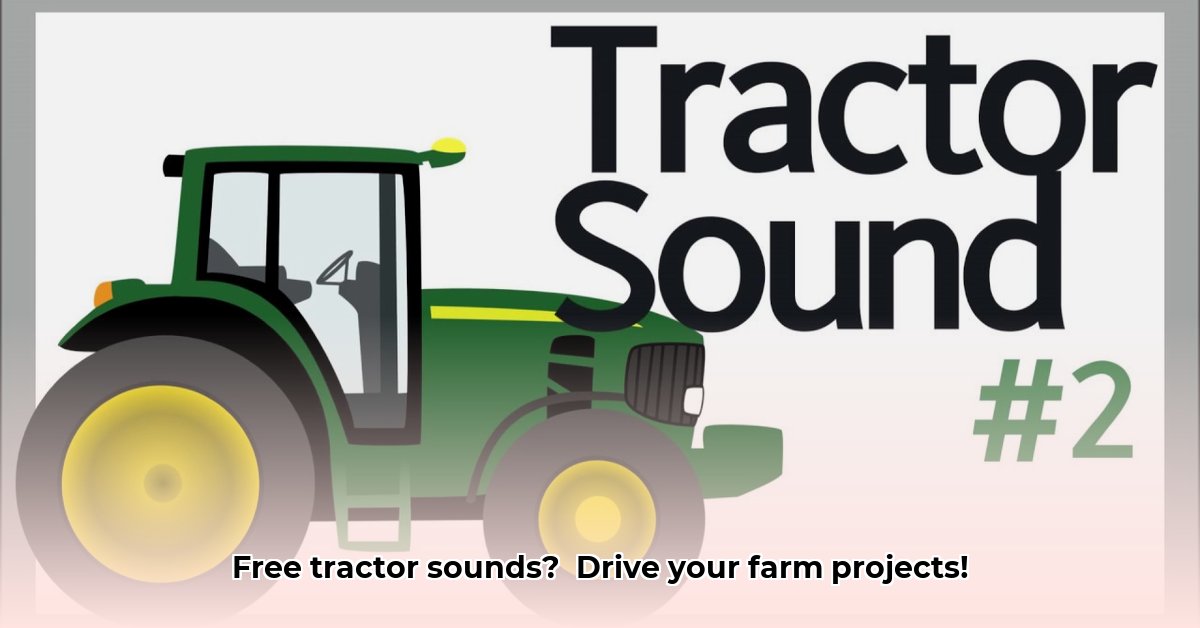
Tractor Sounds: A Free Resource Landscape
The search for high-quality tractor sound effects for various projects—from educational videos to video games—has been simplified by the readily available free, open-source options online. Platforms like Pixabay1 offer a vast library, reflecting a broader trend of increased digital resource accessibility. However, this convenience presents challenges, most notably inconsistencies in licensing and metadata. Understanding how to use these sounds legally and ethically is paramount. For further information on classic tractors, check out this John Deere info.
The Rise and Challenges of Free Tractor Sounds
The proliferation of free tractor sounds on websites like Pixabay and Mixkit is beneficial for educators and developers, eliminating financial barriers to high-quality audio. Yet, the lack of consistent licensing standards and detailed descriptions can create confusion, raising the risk of inadvertent copyright infringement.
Benefits of Utilizing Free Tractor Sounds
- Cost Savings: Free resources significantly reduce project budgets.
- Accessibility: Open-source options democratize access to high-quality audio.
- Creative Inspiration: Diverse sound options enhance project creativity.
Drawbacks of Free Tractor Sounds
- Variable Sound Quality: The quality of free sounds varies widely; some are crisp and clear, while others are muffled or tinny.
- Licensing Complexity: Understanding Creative Commons licenses requires careful attention to detail.
- Limited Metadata: Many sound files lack crucial information, such as tractor model or recording environment.
- Potential for Misrepresentation: The ease of access to idyllic tractor sounds might create an unrealistic portrayal of farm life.
The Future of Free Tractor Sounds: A Collaborative Approach
To ensure responsible and effective use of free tractor sounds, collaboration is crucial. This involves improving the quality and consistency of available sounds while also enhancing clarity regarding licensing and correct attribution of sources. A centralized, well-documented database would significantly benefit educators, AgTech developers, and sustainable farming advocates.
| Stakeholder | Short-Term Goals | Long-Term Vision |
|---|---|---|
| Educators | Curate high-quality sounds for educational use | Establish a comprehensive database of thoroughly documented sounds. |
| AgTech Developers | Utilize vetted sound libraries in projects | Advocate for open-source licensing standards and improved sound quality. |
| Sustainable Farming Advocates | Promote ethical and responsible sound usage | Educate on responsible sound use and avoid misleading portrayals of farm life. |
| Sound Platforms/Copyright Holders | Improve license clarity and consistency. | Collaborate on best practices with the open-source community. |
How to Ethically Source Royalty-Free Tractor Sound Effects
The demand for authentic agricultural sound effects is growing, particularly in sustainable agriculture projects. This necessitates a responsible approach to sourcing and using these sounds, ensuring compliance with copyright laws.
Utilizing Free Resources: Pixabay and Beyond
Platforms like Pixabay offer numerous royalty-free sounds, but their limitations include a lack of diversity and inconsistent high-fidelity recordings. Locating specific sounds requires careful searching and evaluation.
Understanding Licensing
"Royalty-free" doesn't imply unrestricted use. Always carefully review license terms, ensuring compliance with usage rights and attribution requirements. Neglecting to do so can lead to legal challenges.
Investing in Premium Libraries
For high-quality audio, professional royalty-free libraries offer broader selections and superior sound quality. However, costs are higher than free resources, reflecting the production investment.
Creating Original Sound Effects
Recording original sound effects offers maximum control and eliminates licensing concerns. However, it requires specialized equipment and expertise.
Ethical Sourcing Checklist
Before using any sound effect:
- Verify the License: Scrutinize the license agreement for usage restrictions.
- Check Attribution Requirements: Adhere to any required attribution guidelines.
- Respect Intellectual Property: Recognize and respect copyright laws.
- Prioritize Quality: Choose high-quality sounds when possible.
- Consider Project Needs: Determine the type and quantity of sounds required.
Comparison of Different Sourcing Approaches
| Approach | Pros | Cons |
|---|---|---|
| Free Royalty-Free Libraries | Cost-effective and readily accessible. | Limited selection, potentially lower quality, and potential for outdated or inappropriate sounds. |
| Premium Royalty-Free Libraries | Higher quality sounds, extensive selections, detailed metadata | Higher cost, requiring careful license review. |
| Custom Sound Creation | Complete control and avoidance of licensing issues. | Requires significant expertise and equipment, time-consuming. |